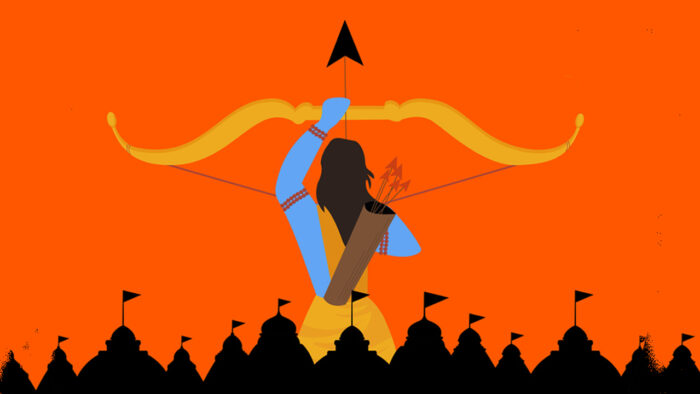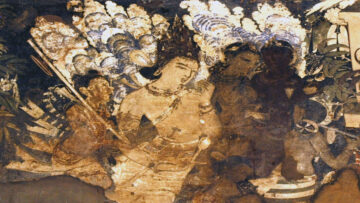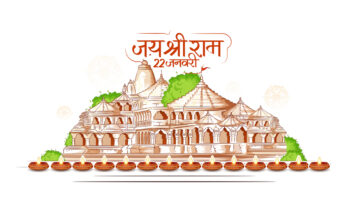In light of the auspicious inauguration of Sri Rama Mandiram in Ayodhya, what better way to celebrate than by transforming it with a literary extravaganza! Let’s embark on a captivating journey by exploring select verses from various works on the Ramayana, beginning with the magnum opus of the Adikavi, Valmiki’s Ramayanam. The Ramayana stands as an epic that has been translated into most languages, holding a special place in the hearts of all Sri Rama devotees. In fact, in Valmiki Ramayana’s BalaKanda, a profound verse declares, “As long as the mountains exist and rivers flow on this earth, so long will the Ramayana flourish,” a prophecy we witness even now.
यावत्स्थास्यन्तिगिरयःसरितश्चमहीतले|
तावद्रामायणकथालोकेषुप्रचरिष्यति|| १-२-३६
yāvatsthāsyantigirayaḥsaritaścamahītale
tāvadrāmāyaṇakathālokeṣupracariṣyati || 1-2-36
Swami Vedanta Desika, a Srivaishnavite Acharya, poet, and logician, when describing Ramaavatara in Dashavatarastotra, reverently refers to Lord Rama as “सर्वावस्थसकृत्प्रपन्नजनतासंरक्षणैकव्रती” (sarvāvasthasakṛtprapannajanatāsaṃrakṣaṇaikavratī), signifying the one who has solemnly vowed to protect his devotees in every circumstance. Additionally, Swami Desika eloquently describes Shri Rama as “धर्मोविग्रहवान्”(dharmovigrahavān), portraying Lord Rama as the embodiment of righteousness, suggesting that if Dharma were to manifest in a form, it would be in the divine figure of Lord Rama. The grandeur of Lord Rama’s greatness is truly awe-inspiring, and witnessing the inauguration of his temple is an auspicious moment of unparalleled significance.
King Bhoja, renowned for his ardent devotion to Sanskrit, is also a distinguished Sanskrit scholar who has authored numerous works. One such masterpiece is the Champu Ramayana, crafted in the Champu style, a fusion of prose and poetry. This literary gem, with Bhoja’s distinct style of intricate wordplay and narration, is a source of delight for any Sanskrit enthusiast. Among its treasures, a verse that stands out for its uniqueness is the depiction of Ahalya’s Shaapavimochana, beautifully captured by Bhoja:
दुःखेसुखेचरजएवबभूवहेतुस्तादृग्विधेमहतिगौतमधर्मपत्न्याः।
यस्माद्गुणेनरजसाविकृतिंगतासारामस्यपादरजसाप्रकृतिंप्रपेदे।।
(duḥkhesukhe ca raja evababhūvahetustādṛgvidhemahatigautamadharmapatnyāḥ।
yasmādguṇenarajasāvikṛtiṃgatāsārāmasyapādarajasāprakṛtiṃprapede।।)
In both joy and sorrow, the term “Rajas” (signifying both dust and quality) emerged as the pivotal factor in Ahalya’s life. It was her Rajo-gunaH that acted as the catalyst for transformation, allowing her to regain her true form through the divine dust particles from Rama’s feet.
This verse not only extols the magnificence of Rama’s divine feet but also showcases a captivating play on words, employing the classic Bhoja style, deftly weaving the multifaceted meanings of the term “Rajas” into its narrative.
In the grandeur of literary creation, Kambar, the illustrious Tamil Poet, penned the epic Ramayanam in Tamil, immortalized as KambaRamayanam. With divine reverence, he inaugurated his masterpiece at Srirangam, within the sacred walls of the Sri Ranganathaswamy temple—the venerable ancestral deity of the Raghus. Kambar’s poetic prowess portrays divine love between Lord Rama and Sita, leaving an indelible mark on the hearts of readers. Even those unfamiliar with KambaRamayanam appreciate the timeless beauty of its closing line, a cherished gem that continues to resonate, proving its enduring delight.
எண்ணஅருநலத்தினாள்இனையள்நின்றுழி
கண்ணொடுகண்இணைகவ்வி, ஒன்றைஒன்று
உண்ணவும், நிலைபெதுஉணர்வும்ஒன்றிட
அண்ணலும்நோக்கினான், அவளும்நோக்கினாள்.
(eṇṇaarunaladhdhināḻinaiyaḻninruzi
ghaṇṇḍhughaṇiṇaighavvi, onraionruu
uṇṇavum, nilaibhdhuuṇarvumonriḍha
aṇṇalumnoghghinān, avaḻumnoghghināḻ.)
The verse in Tamil beautifully captures the moment when Rama and Sita, standing face to face, shared a glance that transcended words. In that profound union of hearts, every nuance of emotion echoed in the silent exchange of gazes. As the world around them held its breath, Rama looked upon Sita, and in return, she gazed back—a reflection of mutual admiration and understanding.
In the realm of Sanskrit poetry, MahakaviKalidasa, renowned for his exquisite similes, crafted the grand epic “Raghuvamsham,” a masterful narrative detailing the history of the Raghuvamsha, encompassing the life story of Rama. One poignant moment Kalidasa elegantly portrays is when Rama, having received the command to spend 14 years in exile, reacts with profound emotion.
पित्रांदत्तांरुदन्रामःप्राङ्महींप्रत्यपद्यत।
पश्चाद्वनायगच्छेतितदाज्ञांमुदितोऽग्रहीत्।। १२॰७।।
pitrāṃdattāṃrudanrāmaḥprāṅmahīṃpratyapadyata।
paścādvanāyagacchetitadājñāṃmudito’grahīt।। 12॰7।।
Upon learning about the bestowed kingship, Rama accepted it with a heavy heart. However, when confronted with the decree to embark on a 14-year forest sojourn, he welcomed it joyfully. Commentaries suggest that this willingness stemmed from his unwavering commitment to obey his father’s command. This vignette highlights Rama’s greatness while also exemplifies his consistent and composed approach to life’s challenges. No wonder he waited for 500 years to reclaim his rightful place in Ayodhya!
When Rama and Sita were living in the forest, they found immense joy and reveled in a blissful married life. This delightful phase is eloquently captured in the play “Uttara Ramacharitram,” composed by the great poet Bhavabhuti. In this work, Rama and Sita fondly recall their nights in the forest, showcasing a beautiful verse that portrays the camaraderie between the divine couple.
किमपिकिमपिमन्दंमनद्मासक्तियोगा-
दविरलितकपोलंजल्पतोरक्रमेण।
अशिथिलपरिरम्भव्यापृतैकैकदोष्णो-
रविदितगतयामारात्रिरेवव्यरंसीत्।।१॰२७।।
kimapikimapimandaṃmanadmāsaktiyogā-
daviralitakapolaṃjalpatorakrameṇa।
aśithilaparirambhavyāpṛtaikaikadoṣṇo-
raviditagatayāmārātrirevavyaraṃsīt।।1॰27।।
As Rama and Sita reminisce about their time in the forest, their conversation flowed endlessly, without pause. Their cheeks, pressed together, revealed an intimacy beyond words. With arms wrapped around each other, lost in dialogue, they remained oblivious to the passage of the night.
Another interesting incident in Ramayana is the rendezvous between Hanuman and Sri Rama. Upon hearing the eloquent introduction by Hanuman, Rama finds himself enchanted, struck by the sweetness of his words. Turning to his brother Lakshmana, Rama inquires about this remarkable being whose speech reflects deep knowledge of grammar and the Vedas, whose words flow with richness. Is he Brahma, the creator, or Siva, the auspicious one? Kambar, the poetic maestro, affectionately dubs Hanuman as “Sollin Selvan,” a title beyond the bounds of time.
“இல்லாதஉலகத்துஎங்கும், இங்குஇவன்இசைகள்கூரக் கல்லாதகலையும், வேதக்கடலுமே” என்னும்காட்சி சொல்லாலேதோன்றிற்றுஅன்றே? யார்கொல்இச்சொல்லின்செல்வன்?- வில்ஆர்தோள்இளையவீர! – விரிஞ்சனோ? விடைவலானோ?
illādhaulaghadhdhueṅghum, iṅghuivanijhaighaḻghūragh ghallādhaghalaiyum, vedhaghghaḍhalume” ennumghāḍhjhi jhllāledhonritruanre? yārkholijhjhollinjhlvan?- vilārdhoḻiḻaiyavīra! – viriñjhano? viḍhaivalāno?
In the illustrious prose of Sri MahaveeraVaibhavam, the magnum opus by Swami Vedanta Desika encapsulating the divine saga of Srimad Ramayana, we find a gem of devotion—a cascade of 92 salutations, each an ode to the resplendent virtues of Lord Rama. Among these, a radiant salutation unveils the glory of the SundaraKandam:
अपारपारावार-परिखा-परिवृत-दवदहन-जवन-पवन-भाव-कपिवर-परिष्वङ्ग-भावित-सर्वस्व-दान।
(apārapārāvāra-parikhā-parivṛta-davadahana-javana-pavana-bhāva-kapivara-pariṣvaṅga-bhāvita-sarvasva-dāna)
Hail to you, Rama, the epitome of boundless grace! You, who embraced Hanuman with unbridled joy upon his return with the auspicious token from Sita, discovered amidst the perilous landscape of Lanka—encircled by the vast expanse of the Ocean, transformed into a fiery fortress. This embrace bestowed upon him every conceivable wealth and blessings, an opulent bestowal of divine favor.
As we deep dive further into the epic clash between Lord Rama and Ravana, we revisit the profound verses of Valmiki Ramayanam, where the Adikavi compares this battle to elements beyond measure. Is there a comparison for the boundless expanse of the sky? Can one truly capture the vastness of the ocean in mere words? Similarly, the war between Rama and Ravana defies comparison, just like attempting to compare the boundless sky or the immeasurable ocean. The verse vividly portrays the enormity of the conflict, reflecting the awe-inspiring and formidable nature of the war that unfolded between these two formidable adversaries.
गगनंगगनाकारंसागरस्सागरोपमः
रमारावणयोर्युद्धंरामरावणयोरिव।। ६-१०७-५३
gaganaṃgaganākāraṃsāgarassāgaropamaḥ
ramārāvaṇayoryuddhaṃrāmarāvaṇayoriva।। 6-107-53
Through the course of this article we have discovered many hues of the Ramayana capturing multiple facets of Sri Rama’s life through different literary works. We stand witness to the grand inauguration of the Rama Mandiram in Ayodhya—a momentous event destined to echo through the corridors of time. What better way to sum up this article than to embrace the poignant beauty of a closing verse from Sri MahavIravaibhavam by the venerable Swami Vedanta Desika. In this verse, he extends his humble obeisance to Lord Rama, the sovereign adorned with Sita, surrounded by his progeny from Brahma onward:
चतुर्मुखेश्वरमुखैःपुत्रपौत्रादिशालिने।
नमःसीतासमेतायरामायगृहमेधिने॥
caturmukheśvaramukhaiḥputrapautrādiśāline।
namaḥsītāsametāyarāmāyagṛhamedhine॥
Feature Image Credit: istockphoto.com
Disclaimer: The opinions expressed in this article belong to the author. Indic Today is neither responsible nor liable for the accuracy, completeness, suitability, or validity of any information in the article.











